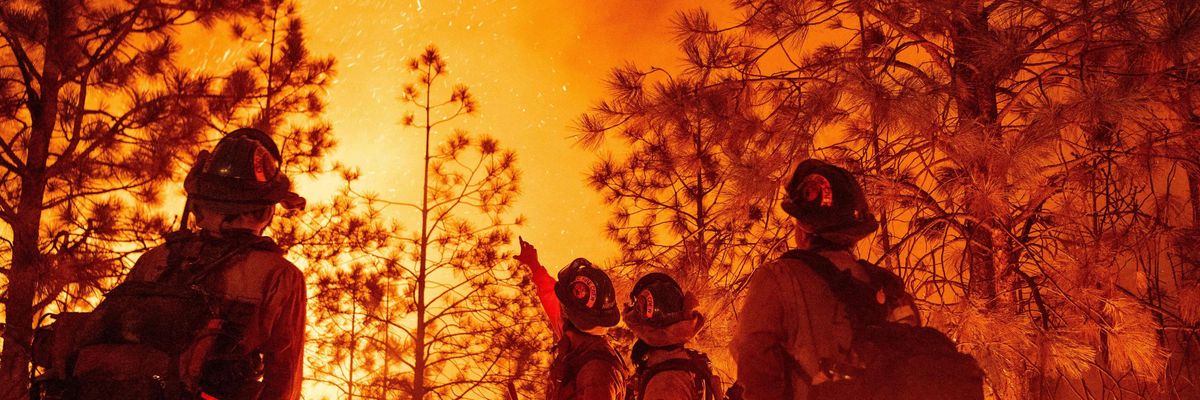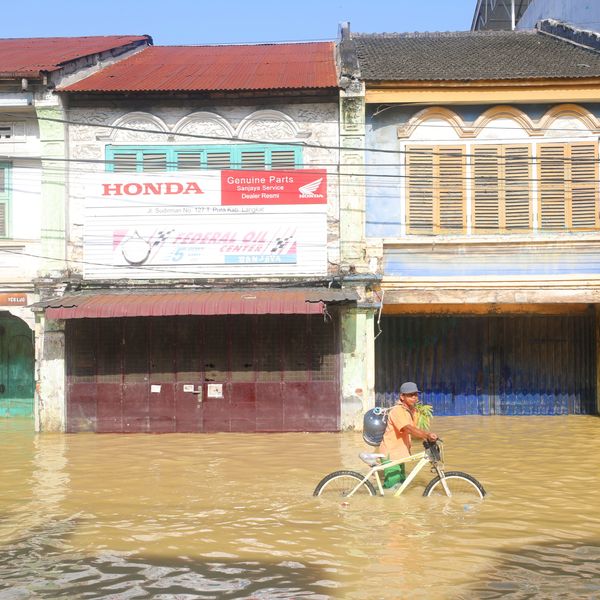
CalFire firefighters monitor the Mosquito fire in Foresthill, California on September 13, 2022. (Photo: Josh Edelson/AFP via Getty Images)
Western Wildfires Cause Extreme Weather Up to 1,500 Miles Away: Study
Wildfires in California were linked to heavier rainstorms and intense hailstorms forming as far away as Nebraska and Oklahoma.
With the climate crises driving a more intense and longer wildfire season in the United States, new groundbreaking research reveals the cascading impacts of a world in which such fires can create damaging weather halfway across the country.
Hundreds of thousands of wildfires have burned through nearly seven million acres of land across the West so far this year, but a study released Monday shows the devastating impact the blazes can have across the country as the rising heat causes other extreme weather events as far as 1,500 miles away.
The U.S. Department of Energy's Pacific Northwest National Laboratory for the first time showed the link between wildfires in western states including California and extreme hail and rainstorms in states as far away as Nebraska and Oklahoma.
According to the study, which was published in the journal Proceedings of the National Academy of Sciences, the extreme heat created by wildfires can shift air pressure and create strong winds that flow eastward and carry moisture in the atmosphere into storms that are already forming.
Both moist air and strong winds can fuel strong thunderstorms, as they did in one 2018 case studied by scientist Jiwen Fan and other researchers.
Fan and her team used a weather model to add the effects of heat and smoke coming from that year's wildfire season in California to simulate a rainstorm and found that the western fires, though far away from the storm, increased the occurrence of heavy rainfall by 38%.
"Western wildfires significantly increase the intensity of severe storms over the central United States," Fan told The Guardian. "This is the first study where we are really showing that wildfires can have a significant impact on the downstream weather."
Wildfires can also create more intense hailstorms several states away, the study showed, as ash and other particles rise from the blazes and flow into storm zones.
As National Geographic reported:
Water condenses out of air more easily when it has something to latch onto: More particles offer more chances to attach. And if those particles get sucked into a strong updraft, shooting into ever-colder air above, they have more chances to form hail. Previous research has demonstrated that smoke particles often induced bigger hailstones in the Central United States.
Both larger hailstorms and more intense rainfall can damage infrastructure and crops and cause millions of dollars in damage.
"The cost of the storms we studied exceeded $100 million in damage," Yuwei Zhang, a co-author of the study, told The Guardian.
\u201cWhen wildfires lead to hail, we know that climate crises can worsen each other - and that's bad news for people's health and safety. https://t.co/Hx4ifBRfEV\u201d— Food & Water Watch (@Food & Water Watch) 1666098004
As Common Dreams reported in 2021, intense wildfires during last year's fire season in the West generated its own weather by forming pyrocumulus clouds which "essentially become their own thunderstorms and can contain lightning and strong winds."
Fan's study is the first to show how wildfires can change and intensify storms half a continent away, however.
An Urgent Message From Our Co-Founder
Dear Common Dreams reader, The U.S. is on a fast track to authoritarianism like nothing I've ever seen. Meanwhile, corporate news outlets are utterly capitulating to Trump, twisting their coverage to avoid drawing his ire while lining up to stuff cash in his pockets. That's why I believe that Common Dreams is doing the best and most consequential reporting that we've ever done. Our small but mighty team is a progressive reporting powerhouse, covering the news every day that the corporate media never will. Our mission has always been simple: To inform. To inspire. And to ignite change for the common good. Now here's the key piece that I want all our readers to understand: None of this would be possible without your financial support. That's not just some fundraising cliche. It's the absolute and literal truth. We don't accept corporate advertising and never will. We don't have a paywall because we don't think people should be blocked from critical news based on their ability to pay. Everything we do is funded by the donations of readers like you. Will you donate now to help power the nonprofit, independent reporting of Common Dreams? Thank you for being a vital member of our community. Together, we can keep independent journalism alive when it’s needed most. - Craig Brown, Co-founder |
With the climate crises driving a more intense and longer wildfire season in the United States, new groundbreaking research reveals the cascading impacts of a world in which such fires can create damaging weather halfway across the country.
Hundreds of thousands of wildfires have burned through nearly seven million acres of land across the West so far this year, but a study released Monday shows the devastating impact the blazes can have across the country as the rising heat causes other extreme weather events as far as 1,500 miles away.
The U.S. Department of Energy's Pacific Northwest National Laboratory for the first time showed the link between wildfires in western states including California and extreme hail and rainstorms in states as far away as Nebraska and Oklahoma.
According to the study, which was published in the journal Proceedings of the National Academy of Sciences, the extreme heat created by wildfires can shift air pressure and create strong winds that flow eastward and carry moisture in the atmosphere into storms that are already forming.
Both moist air and strong winds can fuel strong thunderstorms, as they did in one 2018 case studied by scientist Jiwen Fan and other researchers.
Fan and her team used a weather model to add the effects of heat and smoke coming from that year's wildfire season in California to simulate a rainstorm and found that the western fires, though far away from the storm, increased the occurrence of heavy rainfall by 38%.
"Western wildfires significantly increase the intensity of severe storms over the central United States," Fan told The Guardian. "This is the first study where we are really showing that wildfires can have a significant impact on the downstream weather."
Wildfires can also create more intense hailstorms several states away, the study showed, as ash and other particles rise from the blazes and flow into storm zones.
As National Geographic reported:
Water condenses out of air more easily when it has something to latch onto: More particles offer more chances to attach. And if those particles get sucked into a strong updraft, shooting into ever-colder air above, they have more chances to form hail. Previous research has demonstrated that smoke particles often induced bigger hailstones in the Central United States.
Both larger hailstorms and more intense rainfall can damage infrastructure and crops and cause millions of dollars in damage.
"The cost of the storms we studied exceeded $100 million in damage," Yuwei Zhang, a co-author of the study, told The Guardian.
\u201cWhen wildfires lead to hail, we know that climate crises can worsen each other - and that's bad news for people's health and safety. https://t.co/Hx4ifBRfEV\u201d— Food & Water Watch (@Food & Water Watch) 1666098004
As Common Dreams reported in 2021, intense wildfires during last year's fire season in the West generated its own weather by forming pyrocumulus clouds which "essentially become their own thunderstorms and can contain lightning and strong winds."
Fan's study is the first to show how wildfires can change and intensify storms half a continent away, however.
With the climate crises driving a more intense and longer wildfire season in the United States, new groundbreaking research reveals the cascading impacts of a world in which such fires can create damaging weather halfway across the country.
Hundreds of thousands of wildfires have burned through nearly seven million acres of land across the West so far this year, but a study released Monday shows the devastating impact the blazes can have across the country as the rising heat causes other extreme weather events as far as 1,500 miles away.
The U.S. Department of Energy's Pacific Northwest National Laboratory for the first time showed the link between wildfires in western states including California and extreme hail and rainstorms in states as far away as Nebraska and Oklahoma.
According to the study, which was published in the journal Proceedings of the National Academy of Sciences, the extreme heat created by wildfires can shift air pressure and create strong winds that flow eastward and carry moisture in the atmosphere into storms that are already forming.
Both moist air and strong winds can fuel strong thunderstorms, as they did in one 2018 case studied by scientist Jiwen Fan and other researchers.
Fan and her team used a weather model to add the effects of heat and smoke coming from that year's wildfire season in California to simulate a rainstorm and found that the western fires, though far away from the storm, increased the occurrence of heavy rainfall by 38%.
"Western wildfires significantly increase the intensity of severe storms over the central United States," Fan told The Guardian. "This is the first study where we are really showing that wildfires can have a significant impact on the downstream weather."
Wildfires can also create more intense hailstorms several states away, the study showed, as ash and other particles rise from the blazes and flow into storm zones.
As National Geographic reported:
Water condenses out of air more easily when it has something to latch onto: More particles offer more chances to attach. And if those particles get sucked into a strong updraft, shooting into ever-colder air above, they have more chances to form hail. Previous research has demonstrated that smoke particles often induced bigger hailstones in the Central United States.
Both larger hailstorms and more intense rainfall can damage infrastructure and crops and cause millions of dollars in damage.
"The cost of the storms we studied exceeded $100 million in damage," Yuwei Zhang, a co-author of the study, told The Guardian.
\u201cWhen wildfires lead to hail, we know that climate crises can worsen each other - and that's bad news for people's health and safety. https://t.co/Hx4ifBRfEV\u201d— Food & Water Watch (@Food & Water Watch) 1666098004
As Common Dreams reported in 2021, intense wildfires during last year's fire season in the West generated its own weather by forming pyrocumulus clouds which "essentially become their own thunderstorms and can contain lightning and strong winds."
Fan's study is the first to show how wildfires can change and intensify storms half a continent away, however.

